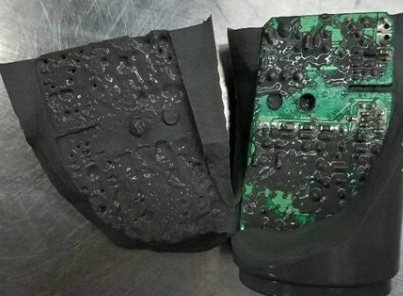What is the reason for the poisoning of electronic potting glue and the non-curing? How to fix it?
The non-curing of electronic potting adhesive poisoning is a common problem in the field of electronic packaging, which is mainly manifested in the failure of the glue to be completely cured into an elastic soft glue, or the hardness is low after curing, and the surface is sticky.

The reasons for the different poisoning of electronic potting gels mainly include the following aspects:
1. Proportioning problem: Electronic potting compound is usually composed of two components, A and B, and their proportioning needs to be carried out in strict accordance with the instructions or TDS (Technical Data Sheet). If the dosing is not accurate, it may result in the encapsulant not curing.
2. Improper or expired storage conditions: The storage environment of the potting compound has a significant impact on its performance. If the storage environment is not suitable (e.g., too high temperature, excessive humidity, etc.) or the encapsulant has expired, the catalyst inside may fail, resulting in a failure to cure.
3. Contamination problem: During the use of the encapsulant compound, it may come into contact with some substances that will inhibit its solidification, such as sulfur, phosphorus, arsenic and other compounds, as well as oil sludge, clay and other substances that may contaminate the catalyst. These contaminants can react with the catalyst in the encapsulant and cause it to fail to cure.
4. Operational problems: During operation, if the correct steps are not followed for mixing or curing, it may also cause the encapsulant to fail to cure. For example, uneven mixing, insufficient curing time, or too low a temperature can affect the curing results.
.png)
Here are some specific strategies to address this issue:
一. Check and avoid pollution sources
1. Identify the source of pollution:
- Check that the encapsulant has been exposed to substances that can cause poisoning, such as compounds such as sulfur, phosphorus, arsenic, etc., as well as substances such as sludge and clay that may contaminate the catalyst.
- Pay special attention to chemicals that may remain on the circuit board, such as rosin flux, release agent on plastic surfaces, insulating paper/insulating tape, etc.
2. Isolate the source of pollution:
- Avoid direct contact between the encapsulant and the above-mentioned contamination sources, ensure that the work area and tools are clean and free of contamination, and if the encapsulant has been contaminated and cannot be completely removed, it can be isolated by using a barrier layer (e.g. conformal coating) or cleaning agent.
二. Dispose of the poisoned potting compound
1. Cleaning and removal:
- If possible, try to remove or wash the part that contains the contaminant. You can use water to dilute a wipe with alcohol and acetone for soaking and cleaning.
2. Repotting:
- After cleaning, remix the encapsulant for potting. Make sure to follow the dosage and steps required by the instructions.
三. Adjust the curing conditions
1. Control curing time and temperature:
- Ensure that the curing time and temperature meet the instructions for the encapsulant. Thermostatic heating equipment can be used to keep the temperature stable.
- At low temperatures, it may be necessary to increase the temperature to meet the curing requirements.
四. Replace the potting compound or adjust the production process
1. Change the brand of potting compound:
- If the problem is not resolved after the above treatment, you can consider changing the encapsulant brand. Different brands of encapsulants differ in performance and use.
2. Adjust the production process:
- Inspect and optimize the production process to ensure that each step meets the requirements for the use of potting compound.
五. Other precautions
1. Ensure the quality of the encapsulant:
- Choose a reliable and certified encapsulant product.
2. Storage conditions:
- Store the encapsulant in a dry, cool, ventilated place away from direct sunlight and high temperatures. At the same time, pay attention to check the expiration date of the potting gel to ensure that it is used within the expiration date.
3. Operational Specifications:
- During operation, follow the steps and precautions required by the instructions, and follow the operation steps in the instructions for mixing and curing. Make sure that the mixture is homogeneous, and the curing time and temperature meet the requirements. If possible, thermostatic heating equipment can be used to keep the curing temperature stable. Avoid poor curing caused by improper handling.
4. Compatibility Test:
- If there is doubt as to whether certain surfaces or materials will inhibit curing, it is recommended to conduct a small compatibility test to determine their suitability for a particular application.
Through the above measures, the problem of non-curing poisoning of electronic potting adhesive can be effectively solved, and the product quality and production efficiency can be improved.








